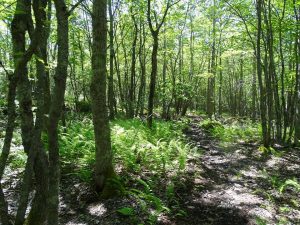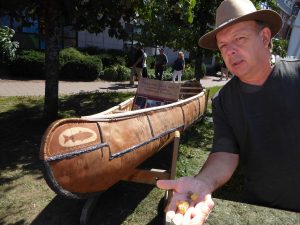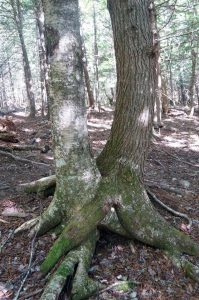Each generation must make their own journey through a thick terrain.
How ever we get lost along the way, let us rejoice in the healing steps that follow.
I hope we all continue to gather at the edge of the woods where the generations before us and after us re-merge.
– Prologue to Generations Re-Merging by Shalan Joudry
Two recent news stories illustrate these journeys, one about loss, the second about healing.
Zack Metcalfe is a young journalist and unapologetic tree-hugger who writes a column on the “Endangered Perspective” in the Chronicle Herald. In No business outliving Nova Scotia’s forests (CH, Nov 20, 2017), he expresses feelings that were shared by Nova Scotians of all ages at the Forest Funeral.
In early November, Zack visited “perhaps the finest hardwood forest” he had ever seen, on the St. Mary’s River:
Its dominant trees, gigantic sugar maples and yellow birch, were of a hardwood maturity I’d only come across once before in this province, spaced out as though to welcome venturing primates with robust barks and winding routes to the sky. Their leaves had fallen, save for the odd American beech whose oranges and reds gave a splash of colour to these hibernating greys…
The ground was spongy with mosses and their barks were blanketed with lichens, some I know to be increasingly uncommon. These trees were strong, healthy, and most importantly they were rare, the sort of well aged amalgam we’ve harvested into scarcity over four centuries. If there’s anything our forests lack these days, it’s seniority, yet here were elders, standing against ferocious winds, outbreaks of insects and the natural ravages of childhood, falling finally to our economic whims.
But says Zack, it “was a bittersweet hike this forest offered me…because now the axes are coming, destined to dismantle many of the trunks I pressed my hand against sometime soon”, and so
With solemn steps I bid farewell to trees I had no business outliving.
The second story is about a forest culture almost lost and now undergoing a rebirth. Todd Labrador was recently named Creative Nova Scotia’s Indigenous artist of the year for his efforts to revive Mi’kmaw birch bark canoe building. From the announcement:
Indigenous Artist Recognition Award Winner 2017
Todd Labrador“Amaikat Sam’qwanijtuk“
“One who dances on water”
Todd Labrador explains how he makes the glues from tree resins and bear fat. (At the Tall Ships event in Halifax, July 30)
Nova Scotian Mi’kmaw artisan Todd Labrador is a self-taught artisan. Best known for building amazing traditional birch bark canoes. Born in 1960 he was raised on the Wildcat reservation in Queen’s County NS. Surrounded by nature he was emerged in the stories of his great grandfather Joe Jermey who was a traditional canoe builder born in 1874 and raised Todd’s father.Taking the road less travelled he has worked diligently to revive Mi’kmaw birch bark canoe building…
Mi’kmaq historian Daniel Paul wrote about Todd in 2009 with this introduction:
During the European invasion of the Americas, European sailors and historians often commented about the great seaman skills of First Nation Peoples. The Mi’kmaq in particular were singled out as among the greatest sailors in the world. One Englishman commented “they sailed as if they were born to it.”
Their seaman skills were also evident in warfare. Mi’kmaq warriors, during their 130 year war with the British, often seized British ships, something in the neighborhood of 85 boats over the period of time mentioned.As well as rivers and lakes, the Mi’kmaq were at home on the Ocean. They often travelled far distances over the waters of the North Atlantic. Trips to the Island of Newfoundland were common, and who knows, they may have went beyond the Island from time to time and on a few occasions “discovered” Europe.
Daniel reprinted the text of an article (Transforming bark to boat) carried in the Chronicle Harold on April 8, 2009 “about the skills of a modern day Birch Bark Canoe maker, Todd Labrador. It’s a fascinating tale about the efforts of a dedicated Mi’kmaw to carry on the canoe making skills developed by his ancestors”. View Daniel N. Paul: Todd Labrador’s Mi’kmaq Birchbark Canoe
There is much more to this story of loss and rebirth of a forest culture. Perhaps it offers a path for Zack and others who mourn the degradation of our forests to find their own healing.
Labrador’s father used to tell him the trees hold hands beneath the forest floor.“They’re supporting each other. Their hands and their roots are intertwined. He said nature is sending us the message that we as human beings need to do the same, regardless of colour of skin, regardless of religion, race,” Labrador says.
“If we come together and hold hands and support each other, we’ll be much stronger. He said that’s the message that Mother Nature is constantly telling us, but only some of us will hear that message, a lot of us won’t. – Todd Labrador
– From Finding their root (CBC Interactive by Elizabeth McMillan, Oct 2017)
A few links
By Zack M
Solitude speaks volumes in rare forests of Nova Scotia
Chronicle Herald, September 17, 2017. About taking stock of old growth in hidden areas of the province
A relic from an uninformed time
South Shore Breaker, June 6, 2017, written after an “intimate” visit to a clearcut
Huge wolves, caribou and bears once roamed P.E.I.’s old growth forests
The Guardian, Sep 1, 2017. “So this Island of ours was once the picture of wildness, its native flora and fauna a worthy challenger for any neighbouring province, although long since tamed into oblivion. It’s a side of Prince Edward Island I would give anything to see, but for now it’s enough to know that, if you look deep enough into its rusty red dirt, you’ll find history.”
On Todd Labrador and forest culture
Returning to their Roots (Audio, 26 min)
Atlantic Voice with Angela Antle Oct 15, 2017. “We follow Todd Labrador, a seventh generation canoe builder, his daughter Melissa, and four apprentices on a five month journey as they build a traditional birchbark canoe. Elizabeth McMillan produced this documentary.”
Wildcat River family keeps Mi’kmaq tradition afloat
Lindsay Jones for Globe and Mail, June 27, 2017. “A birchbark canoe builder’s watercraft will be displayed in Gatineau, with a story that goes back generations.”

TheGreenInterview
Todd Labrador, philosopher and canoe builder of the Acadia First Nation, in conversation with Silver Donald Cameron.
Finding their root
CBC Interactive by Elizabeth McMillan, Oct 2017. “A remarkable canoe was built by many hands under the guidance of one of the country’s few Mi’kmaq canoe builders.”
Unama’ki Institute of Natural Resources: Netukulimk
An explanation of the Mi’kmaw concept of Netukulimk “The Mi’kmaw word for sustainability in my humble opion is encompassed in that word Netukulimk” – Albert Marshall
Acadian Forest Love Affair
About my discovery of the trees holding hands that Todd Labrador talks about
Puktewei: Learning from Fire in Mi’kma’ki (Mi’kmaq Territory)
Shalan Joudry, MES thesis. The author takes the reader on her journey to explore the interaction between indigenous and scientific ways of learning about our world.




